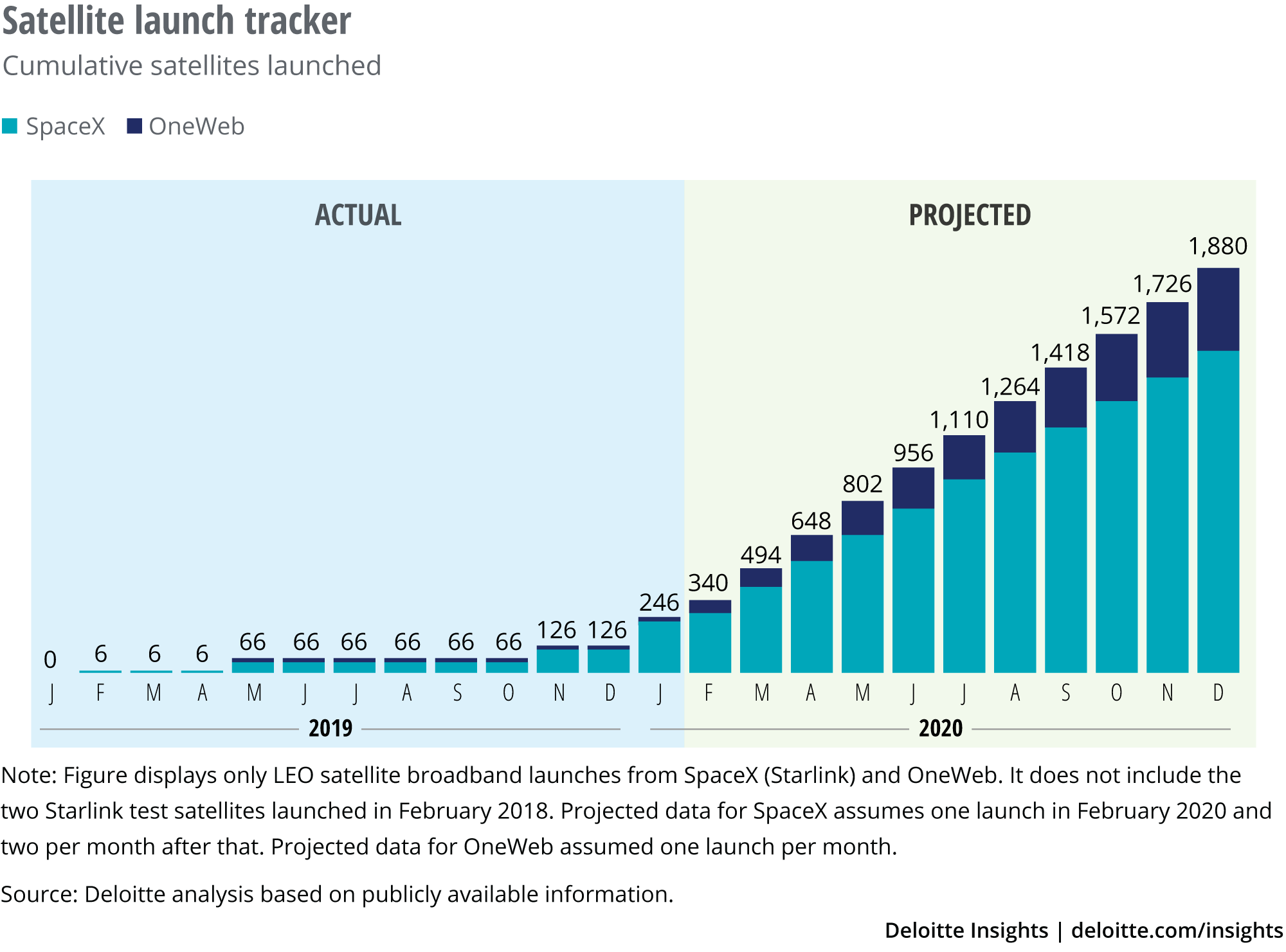The satellite broadband industry is moving at hyperspeed This year could be make-or-break for low Earth orbit (LEO)–based satellite broadband internet
4 minute read
19 February 2020
Companies are competing to bring global populations affordable high-speed internet service through "megaconstellations" of satellites. Who will win the race to achieve a sustainable and profitable approach?

We are in the midst of another space race, with participants competing not to reach the moon or Mars but to connect the world’s unconnected and underconnected populations. Deloitte’s recent Technology, Media, and Telecommunications Predictions 2020 report details how a number of companies are working to build and deploy “megaconstellations” of hundreds or thousands of satellites to bring affordable high-speed internet services to businesses, governments, schools, and individuals around the world.
These companies are looking to provide a multitude of potential applications such as:
- Better connectivity for the transportation industry (ships, trains, planes)
- Communication backbones for IoT devices for processes such as fleet management and remote maintenance
- Infrastructure or mobile backhaul for other communications companies
- Services for the direct-to-consumer market, including rural and other areas with poor or no service
- Government services, such as education and emergency response
Learn more
Read the most recent charticle on the most valued technology of the last decade
Explore the Thinking Fast series library
Subscribe and never miss a charticle
Learn about Deloitte’s services
Go straight to smart. Get the Deloitte Insights app.
Hundreds of satellites are already in orbit as part of these growing networks, with hundreds more slated to launch this year. Amid many technical and business challenges, the question is who will be first to achieve a sustainable and profitable approach.
The industry is moving at a breakneck pace, with a number of new developments occurring just since our Predictions 2020 report was released:
- SpaceX now operates the world’s largest satellite constellation. In total, as of this publication, the company has launched 302 Starlink satellites.1 Executives aim to begin providing service later this year and are planning up to 24 total launches in 2020.2
- OneWeb is ramping up its launch pace and recently sent 34 satellites into orbit from Kazakhstan, bringing the total to 40.3 Executives have stated they are planning to offer service starting in 2021.
- As Amazon awaits final approval for its Project Kuiper from the US Federal Communications Commission, its team is moving to a permanent facility in the Seattle area that will house its growing space-related capabilities.4 To catch up and compete with SpaceX and OneWeb, Amazon will have to accelerate its efforts.
- Finally, some of the industry’s major players are grappling with legal and broader regulatory challenges, including the approval of additional satellites. These and other developments could potentially delay efforts.
Exactly how will customers connect to these constellations through user terminals? That remains unclear. The terminals contain an antenna, receiver, and additional networking equipment; they must be highly reliable and physically robust, technologically advanced, easy to install and use, and inexpensive—in total, a hard ask. Companies have poured a lot of research and investment into this piece of the puzzle, but little is publicly known.5 SpaceX CEO Elon Musk recently described Starlink’s antennas as simple to install and use, looking like “a thin, flat, round UFO on a stick.”6 Much more specificity is needed to better gauge cost and capability.
Organizations shouldn’t wait for these systems to be fully deployed before acting. Now is the time to look at which business areas could be improved with direct access to high-speed broadband internet. Could it dramatically improve current services? Enable new capabilities? Potentially disrupt current business models?
“New LEO satellite-based broadband solutions will likely be in the market within the next year that offer higher speeds, lower latency, expanded global coverage, and improved end user equipment compared to existing satellite solutions,” says Kevin Thompson, managing director in Deloitte Consulting LLP's Telecommunications practice. “If these startup ventures can overcome the technical and economic challenges, we may soon see the era of true global broadband connectivity and the new potential it creates in both the developed and developing world.”
© 2021. See Terms of Use for more information.
More from the Technology collection
-
TMT Predictions 2025 Article4 months ago
-
Determining your future Business of Technology Article5 years ago
-
The digital consumer in 2020 Article4 years ago
-
Rediscovering your identity Article5 years ago
-
A pragmatic pathway for redefining work Article5 years ago
-
How technology OEMs can guide channel partners into XaaS Article5 years ago












